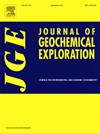Enhancing lithium exploration in the Borborema province, Northeast Brazil: Integrating airborne geophysics, low-density geochemistry, and machine learning algorithms
IF 3.3
2区 地球科学
Q1 GEOCHEMISTRY & GEOPHYSICS
引用次数: 0
Abstract
The increasing demand for lithium, driven by its essential role in renewable energy technologies, implies the development of innovative exploration techniques. This study applies Random Forest regression integrated with low-density geochemistry and airborne gamma-ray data to enhance the resolution and accuracy of lithium concentration maps in soils across the Borborema Province, Northeast Brazil. Our methodology not only refines the mapping of lithium distributions but also identifies potential lithium-rich zones within established and underexplored areas. The predictive model successfully delineates regions with high lithium content (up to 70 ppm), aligning these with known geological features and pegmatite occurrences, thereby validating the model's robustness despite some challenges in predicting extreme values. The research highlights the presence of lithium beyond traditional pegmatite deposits, suggesting a broader geological context for lithium mineralization. Our findings encourage strategic targeting of exploration efforts, which can lead to more economical mining practices. This study demonstrates the potential of integrating advanced data analytics with traditional geological methods to improve the efficiency and reach of lithium exploration, supporting the global transition towards renewable energy sources. Future work should enhance model accuracy, especially at extreme concentration levels, and expand the model's application to other regions with similar geological settings.
加强巴西东北部Borborema省的锂勘探:整合航空地球物理、低密度地球化学和机器学习算法
锂在可再生能源技术中的重要作用推动了锂需求的不断增长,这意味着创新勘探技术的发展。本研究将随机森林回归与低密度地球化学和航空伽马射线数据相结合,提高了巴西东北部Borborema省土壤锂浓度图的分辨率和准确性。我们的方法不仅改进了锂分布的映射,而且还确定了已开发和未开发区域内潜在的富含锂的区域。该预测模型成功地描绘了高锂含量(高达70 ppm)的区域,并将这些区域与已知的地质特征和伟晶岩产状进行了比对,从而验证了模型的稳健性,尽管在预测极端值方面存在一些挑战。该研究强调了锂在传统伟晶岩矿床之外的存在,表明锂矿化的地质背景更广泛。我们的研究结果鼓励了勘探工作的战略目标,这可以导致更经济的采矿实践。这项研究展示了将先进的数据分析与传统地质方法相结合的潜力,以提高锂勘探的效率和范围,支持全球向可再生能源的过渡。未来的工作应该提高模型的精度,特别是在极端浓度水平下,并将模型的应用扩展到具有类似地质背景的其他地区。
本文章由计算机程序翻译,如有差异,请以英文原文为准。
求助全文
约1分钟内获得全文
求助全文
来源期刊

Journal of Geochemical Exploration
地学-地球化学与地球物理
CiteScore
7.40
自引率
7.70%
发文量
148
审稿时长
8.1 months
期刊介绍:
Journal of Geochemical Exploration is mostly dedicated to publication of original studies in exploration and environmental geochemistry and related topics.
Contributions considered of prevalent interest for the journal include researches based on the application of innovative methods to:
define the genesis and the evolution of mineral deposits including transfer of elements in large-scale mineralized areas.
analyze complex systems at the boundaries between bio-geochemistry, metal transport and mineral accumulation.
evaluate effects of historical mining activities on the surface environment.
trace pollutant sources and define their fate and transport models in the near-surface and surface environments involving solid, fluid and aerial matrices.
assess and quantify natural and technogenic radioactivity in the environment.
determine geochemical anomalies and set baseline reference values using compositional data analysis, multivariate statistics and geo-spatial analysis.
assess the impacts of anthropogenic contamination on ecosystems and human health at local and regional scale to prioritize and classify risks through deterministic and stochastic approaches.
Papers dedicated to the presentation of newly developed methods in analytical geochemistry to be applied in the field or in laboratory are also within the topics of interest for the journal.
 求助内容:
求助内容: 应助结果提醒方式:
应助结果提醒方式:


